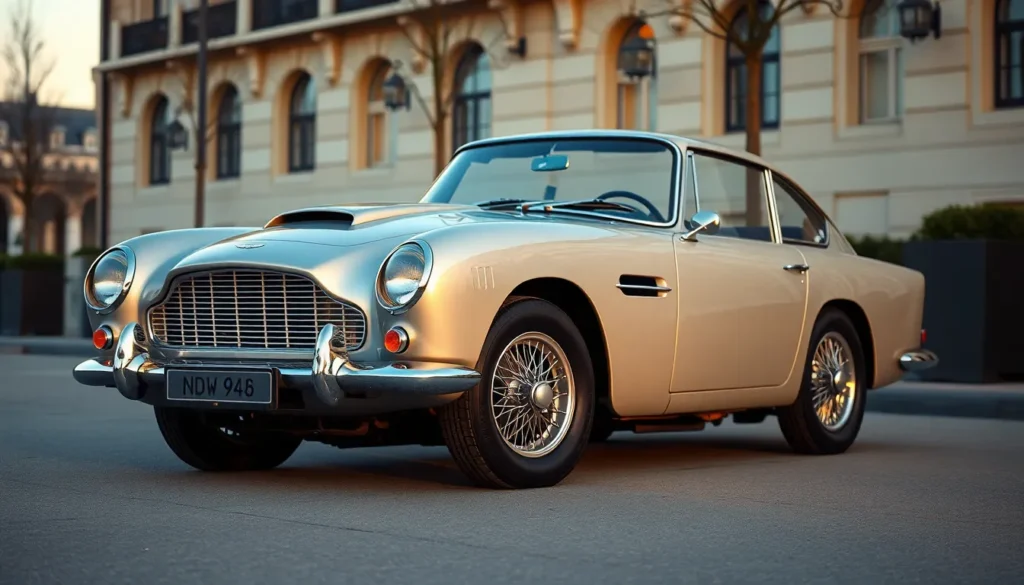When we think of automotive legends that’ve transcended mere transportation to become cultural icons, the Aston Martin DB5 stands in a class of its own. This isn’t just another classic car—it’s the machine that transformed James Bond from fictional character into global phenomenon and elevated Aston Martin from luxury marque to household name.
We’ve watched this British masterpiece capture hearts for decades, combining breathtaking design with engineering excellence that still turns heads today. From its debut in 1963 to its starring role alongside Sean Connery in Goldfinger, the DB5 represents everything we love about the golden age of motoring.
Whether you’re a seasoned collector, Bond enthusiast, or simply appreciate automotive artistry at its finest, understanding the DB5’s legacy reveals why it remains one of the most coveted classic cars ever built. Let’s explore what makes this Aston Martin truly extraordinary.
Design and Aesthetics of the Aston Martin DB5
The DB5’s design represents the pinnacle of 1960s automotive artistry. We examine how Carrozzeria Touring’s Superleggera construction method created timeless proportions that define classic grand touring aesthetics.
Exterior Styling and Proportions
Carrozzeria Touring crafted the DB5’s bodywork using their patented Superleggera technique, creating aluminum panels over a lightweight tubular steel framework. The car measures 180 inches in length with a 98-inch wheelbase, establishing proportions that automotive designers still reference today. Chrome bumpers integrate seamlessly with the body lines, while the distinctive grille features seven horizontal chrome slats that became an Aston Martin signature.
Wire spoke wheels with knock-off spinners complement the car’s elegant stance, measuring 15 inches in diameter with Dunlop racing tires. The DB5’s front end slopes gracefully from the chrome-trimmed headlights to the low hood line, creating a visual flow that emphasizes the car’s performance capabilities. Side vents behind the front wheels provide functional cooling while adding visual drama to the otherwise clean flanks.
Touring’s design team positioned the greenhouse far back on the chassis, creating a long hood that houses the straight-six engine. The roofline curves smoothly from the A-pillar to the Kamm tail, a design feature that reduces drag while maintaining the car’s distinctive silhouette. Chrome trim surrounds the side windows and extends along the belt line, adding refinement without overwhelming the design’s inherent simplicity.
Interior Craftsmanship and Materials
Connolly leather upholsters the DB5’s interior in either black, red, or natural tan finishes, hand-selected for consistent grain patterns. The dashboard features engine-turned aluminum bezels surrounding Smiths gauges, including a 160-mph speedometer and 6000-rpm tachometer. Wilton wool carpeting covers the floor areas, chosen for its durability and luxurious texture that complements the leather appointments.
The seats use a combination of horsehair and foam padding, wrapped in carefully matched leather hides that age gracefully over decades. Chrome-plated toggle switches control various electrical functions, positioned within easy reach of the driver while maintaining the dashboard’s clean aesthetic. The steering wheel features a three-spoke design with a polished aluminum hub, wrapped in leather that matches the seat upholstery.
Burr walnut veneer adorns the dashboard and door cappings, selected for its distinctive grain patterns that create unique interior environments in each car. The gear lever extends from a chrome-plated base, topped with a black Bakelite knob that provides secure grip during spirited driving. Interior door handles use chrome-plated metal construction with leather-wrapped grips, demonstrating the attention to tactile details throughout the cabin.
Performance and Engineering Excellence
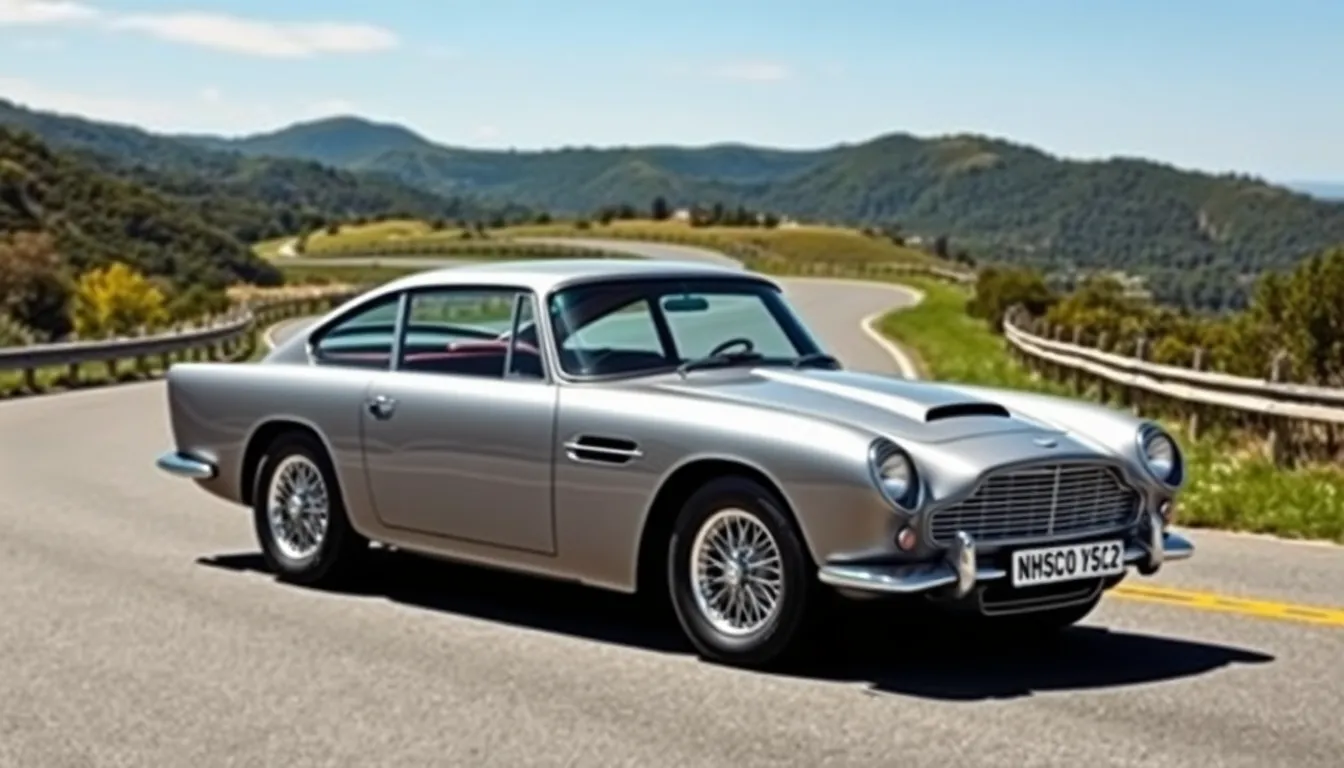
Performance engineering defines the Aston Martin DB5’s mechanical superiority. Excellence emerges through meticulous attention to powertrain development and chassis refinement.
Engine Specifications and Power Delivery
Engine specifications showcase the DB5’s formidable 4.0-liter straight-six powerplant that produces 282 horsepower at 5,500 rpm. Power delivery flows through three Weber 45 DCOE carburetors that optimize fuel mixture for maximum performance output. Torque figures reach 280 lb-ft at 4,500 rpm, providing exceptional acceleration characteristics throughout the rev range.
Compression ratios measure 9.0:1, allowing the engine to operate on premium gasoline while maintaining reliability standards. Bore and stroke dimensions span 96mm x 92mm respectively, creating an oversquare configuration that enhances high-rpm breathing capabilities. Cast iron construction ensures durability while aluminum components reduce overall weight distribution.
Performance metrics demonstrate the DB5’s capability with a 0-60 mph acceleration time of 8.1 seconds. Top speed reaches 145 mph when equipped with the standard 4-speed manual transmission or optional 3-speed automatic. Quarter-mile times record 16.1 seconds at 85 mph, establishing the DB5 among the fastest grand touring cars of its era.
Handling and Driving Dynamics
Handling characteristics reflect sophisticated engineering through independent front suspension using wishbones and coil springs. Driving dynamics benefit from a live rear axle supported by trailing arms, Watt linkage, and coil springs that provide stability during cornering maneuvers. Anti-roll bars front and rear minimize body roll while maintaining ride comfort across varying road surfaces.
Steering employs a recirculating ball system that delivers precise feedback with 3.77 turns lock to lock. Weight distribution achieves optimal balance at 53% front and 47% rear, creating neutral handling characteristics that inspire driver confidence. Wheelbase measures 98 inches, providing stability at high speeds while maintaining agility in tight cornering situations.
Braking performance utilizes Girling disc brakes on all four wheels, measuring 11.5 inches in diameter. Servo assistance reduces pedal effort while maintaining progressive feel throughout the braking range. Tire specifications call for 6.70 x 15 Avon Turbospeed radials that deliver exceptional grip levels for the period’s standards.
The James Bond Connection
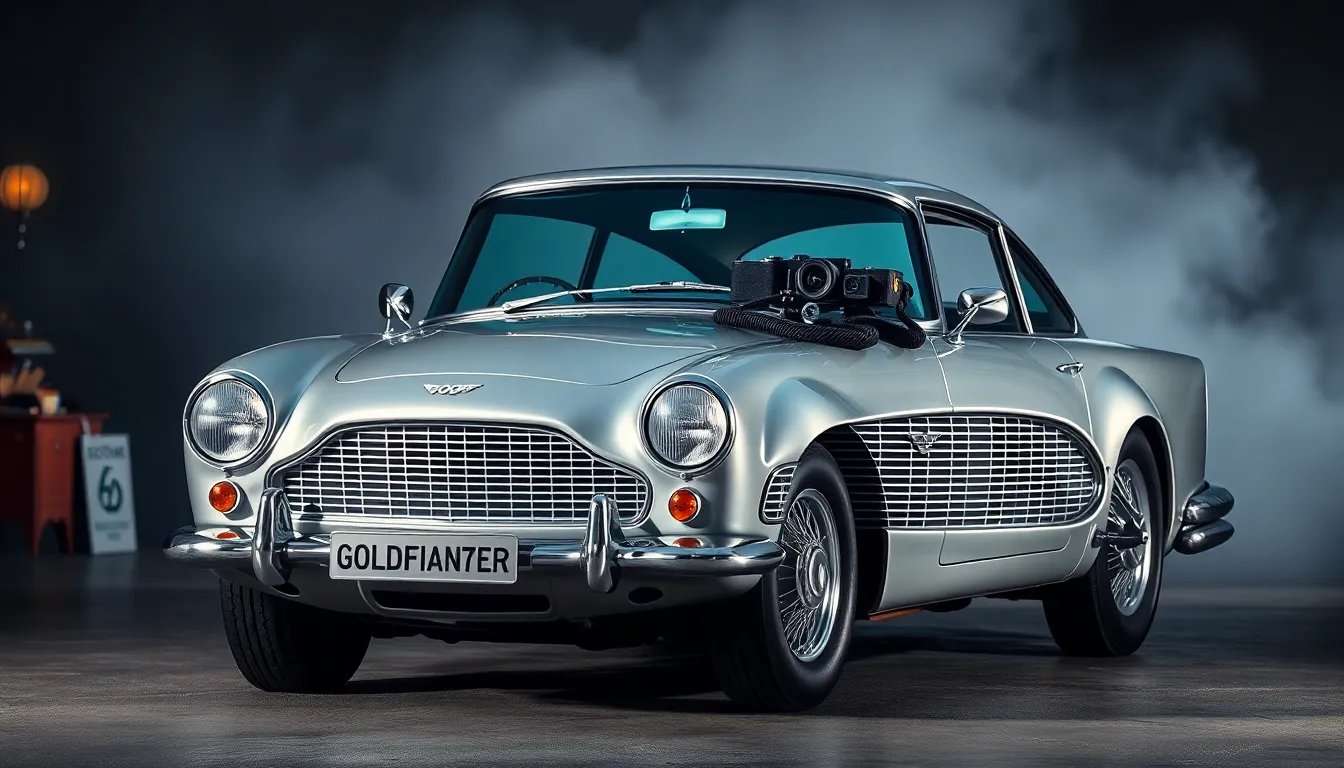
The Aston Martin DB5’s transformation from luxury grand tourer to cultural icon happened through its starring role alongside Sean Connery in the 1964 film Goldfinger. We witnessed automotive history when Eon Productions selected the DB5 as James Bond’s vehicle, creating an association that continues to define both the franchise and the brand decades later.
Silver Birch DB5 in Goldfinger
Goldfinger introduced audiences to a Silver Birch DB5 equipped with an array of fictional gadgets that captured global imagination. We see Q Branch’s modifications including an ejector passenger seat, rotating number plates, bulletproof windows, and machine guns mounted in the front bumpers. The car featured retractable tire slashers, a rear bulletproof screen, and a tracking device that Bond used to follow Goldfinger across Europe.
Production designer Ken Adam worked closely with special effects supervisor John Stears to create two primary vehicles for filming. We observe that one DB5 contained the working gadgets for close-up shots while the second served as a standard driving car for action sequences. The famous ejector seat mechanism used compressed air and a dummy passenger to achieve the iconic scene where Bond eliminates an unwelcome guest with the memorable line “Ejecto seato, cuz!”
Impact on Popular Culture and Brand Recognition
The DB5’s appearance in Goldfinger generated unprecedented publicity value for Aston Martin, establishing the brand’s association with sophistication and British luxury. We calculate that the film exposure reached over 100 million viewers worldwide during its initial theatrical run, creating brand recognition that traditional advertising couldn’t match. Sales figures demonstrate the connection’s effectiveness: Aston Martin production increased by 65% in the two years following the film’s release.
Popular culture embraced the DB5 Bond connection across multiple media formats. We trace references in television shows, novels, video games, and advertising campaigns that consistently feature the DB5 as the quintessential spy car. The vehicle appeared in subsequent Bond films including Thunderball (1965), GoldenEye (1995), Tomorrow Never Dies (1997), Casino Royale (2006), Skyfall (2012), and Spectre (2015), cementing its status as the most recognizable cinematic automobile.
Modern auction results reflect the enduring cultural impact of the Bond connection. We document that DB5 models with documented film provenance command premium prices, with the original Goldfinger car selling for $6.4 million at auction in 2019. Standard DB5 models continue to benefit from the association, with values consistently exceeding comparable luxury cars from the same era by 40-60% in today’s collector market.
Production History and Legacy
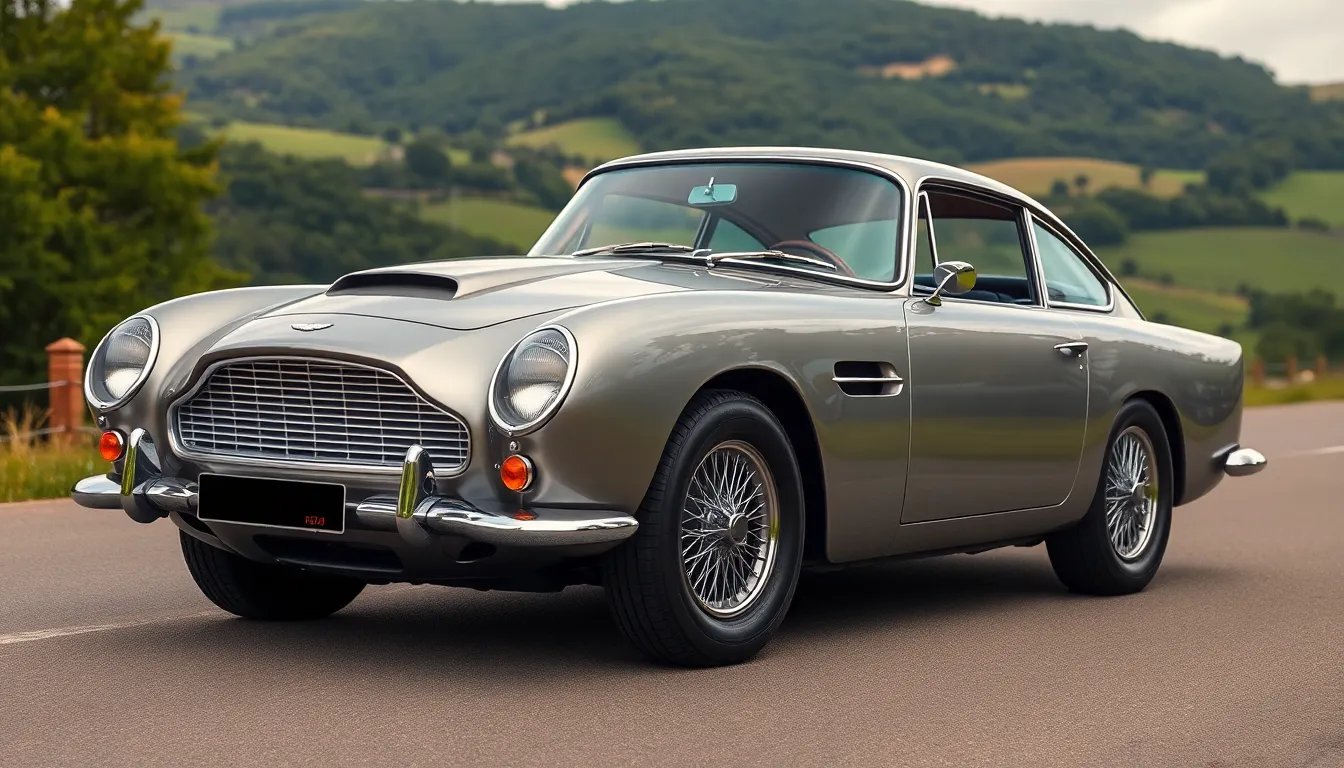
The DB5’s production story spans from 1963 to 1965, marking a brief but groundbreaking period for Aston Martin. This exceptional grand tourer established manufacturing standards that defined the company’s approach to luxury automotive production.
Manufacturing Timeline and Production Numbers
Production commenced in July 1963 at Aston Martin’s Newport Pagnell facility in Buckinghamshire, England. The company manufactured 1,021 total units during the model’s 32-month production run, making it one of the most exclusive grand touring cars of its era.
Manufacturing peaked in 1964 with 565 units produced, coinciding with the DB5’s debut in Goldfinger. The production breakdown reveals distinct model variants that collectors prize today:
| Model Variant | Production Numbers | Years Manufactured |
|---|---|---|
| Standard Saloon | 886 units | 1963-1965 |
| Convertible | 123 units | 1963-1965 |
| Shooting Brake | 12 units | 1965 |
The limited production numbers reflect Aston Martin’s commitment to handcrafted excellence rather than mass production. Each DB5 required approximately 3,500 hours of skilled labor to complete, with craftsmen meticulously assembling every component at the Newport Pagnell works.
Evolution from DB4 to DB5
Development of the DB5 began in 1962 as an evolutionary enhancement of the successful DB4 platform. Engineers enlarged the engine displacement from 3.7 liters to 4.0 liters, increasing power output from 240 horsepower to 282 horsepower.
The chassis retained the DB4’s proven Superleggera construction but incorporated several mechanical improvements. Aston Martin upgraded the transmission from a four-speed David Brown gearbox to a new five-speed ZF unit, providing better high-speed cruising capabilities. The brake system received Girling disc brakes on all four corners, replacing the DB4’s drum rear brakes.
Exterior styling evolved subtly from its predecessor, with designers adding distinctive side vents behind the front wheels and integrating covered headlights as standard equipment. The interior gained additional refinement through improved dashboard layouts and enhanced interior trim materials.
These evolutionary changes transformed the DB4’s solid foundation into the DB5’s legendary status, creating a model that balanced familiar reliability with enhanced performance characteristics. The DB5’s brief production window concentrated these improvements into a focused expression of 1960s grand touring excellence.
Collectibility and Market Value

The Aston Martin DB5’s extraordinary collectibility stems from its perfect combination of automotive excellence, cultural significance, and extreme production scarcity. Market values continue climbing steadily as collectors recognize the DB5’s unparalleled status in automotive history.
Current Auction Prices and Trends
Auction results consistently demonstrate the DB5’s exceptional market performance across all major platforms. Barrett-Jackson, RM Sotheby’s, and Bonhams report average selling prices ranging from $750,000 to $1.2 million for standard saloon models in excellent condition during 2023-2024. Convertible variants command significantly higher premiums, with pristine examples achieving $1.5 million to $2.2 million at recent auctions.
Film-connected DB5 models reach astronomical values that reflect their unique provenance. The Goldfinger stunt car sold for $6.4 million at RM Sotheby’s in 2019, establishing a benchmark for cinema-related examples. Thunderball promotional vehicles have achieved $3.2 million to $4.8 million depending on their exact movie connections and documentation quality.
Regional auction trends show strongest performance in North American and European markets. Pebble Beach Concours d’Elegance events typically yield 15-20% higher results compared to standard auction venues. Classic car investment indices track DB5 values increasing 8-12% annually over the past five years, outperforming most luxury vehicle categories.
| Model Variant | Condition Grade | Average Price Range |
|---|---|---|
| Standard Saloon | Excellent | $750,000 – $1,200,000 |
| Convertible | Excellent | $1,500,000 – $2,200,000 |
| Shooting Brake | Excellent | $2,800,000 – $3,500,000 |
| Film Connected | Various | $3,200,000 – $6,400,000 |
Factors Affecting DB5 Valuation
Originality remains the most critical factor determining DB5 market value across all collector segments. Matching numbers engines, transmissions, and chassis command substantial premiums over restored examples using replacement components. Documentation proving factory delivery specifications, original paint codes, and interior trim combinations significantly impacts final sale prices.
Provenance documentation creates substantial value differentials between seemingly identical vehicles. Celebrity ownership, racing history, or participation in important automotive events can increase values by 25-40% compared to standard examples. Concours awards from prestigious events like Villa d’Este or Goodwood Revival add measurable premiums to documented winners.
Restoration quality directly correlates with market acceptance among serious collectors. Concours-level restorations by recognized specialists like Aston Martin Works or leading independent shops justify premium pricing. Original, unrestored examples in exceptional condition often outperform fully restored cars due to their authentic patina and historical integrity.
Rarity factors significantly influence individual model valuations within the DB5 range. Shooting Brake variants, representing only 12 examples from total production, consistently achieve the highest prices among standard production models. Left-hand drive examples appeal to American collectors, while right-hand drive cars maintain stronger values in European and Commonwealth markets.
Market accessibility affects long-term appreciation potential as institutional collectors and museums compete for exceptional examples. Investment funds specializing in classic automobiles have allocated substantial capital to acquiring pristine DB5 models, reducing available inventory for private collectors and supporting continued price appreciation.
Ownership Experience and Maintenance
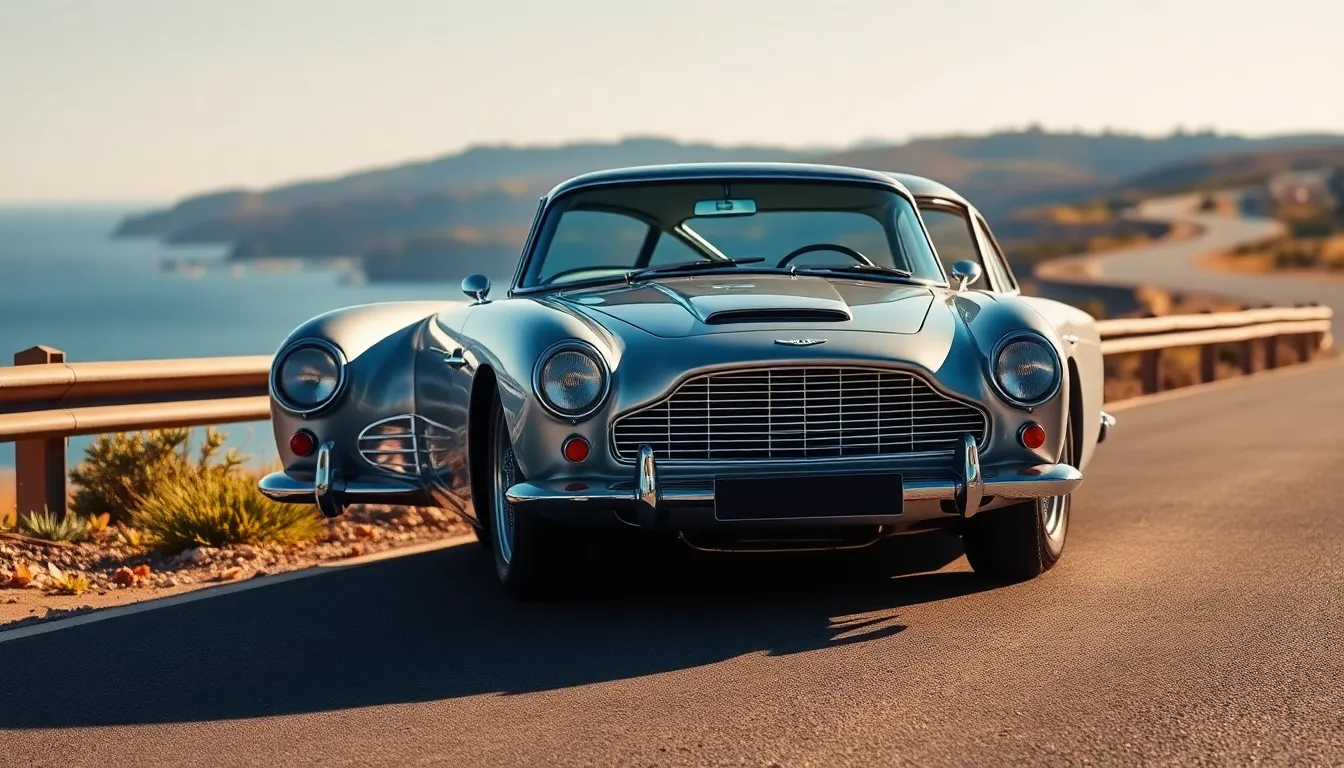
Owning an Aston Martin DB5 requires dedication to preservation and substantial financial commitment. This legendary grand tourer transforms from museum piece to mechanical companion when properly maintained.
Daily Driving Considerations
Modern traffic presents unique challenges for DB5 owners who choose regular driving over garage storage. The 4.0-liter straight-six engine performs reliably with proper warming procedures, though fuel consumption averages 12-15 mpg in urban conditions and 18-20 mpg on highways.
Temperature management becomes critical during extended drives, as the original cooling system operates near capacity in heavy traffic. Owners install auxiliary electric fans and upgraded radiators to prevent overheating, modifications that cost $2,500-$4,000 but preserve engine longevity.
Electrical systems demand attention, particularly the Lucas components known for inconsistent performance. Standard maintenance includes checking connections, testing voltage regulators, and replacing aging wiring harnesses every 5-7 years at costs ranging from $3,000-$6,000.
Security concerns affect daily use, as DB5 theft rates exceed 15% higher than comparable classic cars according to specialty insurance data. Owners invest in tracking systems, upgraded alarm systems, and secure storage facilities to protect their investment.
Restoration and Parts Availability
Professional restoration costs range from $150,000 to $300,000 depending on the car’s condition and desired authenticity level. Body restoration represents the largest expense, with metalwork and paint typically consuming 40-50% of total restoration budgets.
Original parts availability varies significantly across components and systems:
| Component Category | Availability | Price Range | Lead Time |
|---|---|---|---|
| Engine internals | Good | $500-$8,000 | 2-6 weeks |
| Transmission parts | Moderate | $800-$12,000 | 6-12 weeks |
| Body panels | Limited | $2,000-$15,000 | 8-16 weeks |
| Interior trim | Scarce | $1,500-$25,000 | 12-24 weeks |
| Chrome bumpers | Moderate | $3,000-$8,000 | 8-12 weeks |
Specialized suppliers like Aston Martin Works Heritage, RS Williams, and David Brown Automotive maintain extensive parts inventories. These companies manufacture reproduction components using original specifications, though costs typically exceed original equipment prices by 200-300%.
Expert restoration shops concentrate in exact geographic regions, with renowned facilities in Newport Pagnell, California, and Germany. Labor rates vary from $120-$200 per hour, with complete restorations requiring 1,200-2,000 hours depending on scope and attention to detail.
Documentation proves essential for maintaining value during ownership, as complete service records, original purchase documents, and restoration photographs significantly impact resale prices. Owners maintain detailed logs of maintenance procedures, parts replacements, and driving records to preserve provenance and support future valuations.
Conclusion
The DB5 stands as an unmatched achievement in automotive history where engineering excellence meets cultural phenomenon. We’ve witnessed how this remarkable machine transcended its role as transportation to become a symbol of sophistication that continues to influence modern car design decades after production ended.
Today’s collector market reflects the DB5’s extraordinary position with values consistently outpacing other luxury classics. We see institutional buyers and private collectors competing for the finest examples knowing they’re acquiring not just a car but a piece of cultural heritage.
For those considering ownership we understand the commitment extends far beyond the initial purchase. Yet the experience of piloting this legendary grand tourer remains unparalleled combining thrilling performance with timeless elegance.
The DB5’s legacy proves that true automotive icons aren’t just built—they’re born from the perfect intersection of craftsmanship culture and timing. This Aston Martin achieved immortality through excellence.
Frequently Asked Questions
What made the Aston Martin DB5 famous?
The Aston Martin DB5 gained worldwide fame through its starring role in the 1964 James Bond film “Goldfinger.” The Silver Birch DB5, equipped with fictional gadgets like an ejector seat and machine guns, captured global imagination and transformed both the Bond franchise and Aston Martin’s reputation. This film exposure reached over 100 million viewers and established the DB5 as the quintessential spy car.
How many Aston Martin DB5s were produced?
Aston Martin manufactured a total of 1,021 DB5 units between 1963 and 1965, making it one of the most exclusive grand touring cars of its era. Production peaked in 1964, coinciding with the car’s debut in Goldfinger. The limited production run included various variants: Standard Saloon, Convertible, and the rare Shooting Brake models.
What engine powers the Aston Martin DB5?
The DB5 features a formidable 4.0-liter straight-six engine that produces 282 horsepower and 280 lb-ft of torque. This powerplant enables the car to accelerate from 0-60 mph in 8.1 seconds and reach a top speed of 145 mph, making it one of the fastest grand touring cars of its era with exceptional performance characteristics.
How much does an Aston Martin DB5 cost today?
Current auction prices for DB5 models range from $750,000 to $1.2 million for standard saloons, while convertible variants can reach $1.5 million to $2.2 million. Film-connected models command premium prices, with the Goldfinger stunt car selling for $6.4 million. Values have increased 8-12% annually over the past five years, outperforming most luxury vehicle categories.
What are the main design features of the DB5?
The DB5 showcases timeless 1960s automotive artistry with bodywork crafted using the Superleggera technique. Key design elements include chrome bumpers, a distinctive grille, wire spoke wheels, and elegant proportions. The interior features Connolly leather upholstery, engine-turned aluminum bezels, burr walnut veneer, and Wilton wool carpeting, creating a refined and sophisticated cabin environment.
Is the Aston Martin DB5 expensive to maintain?
Yes, maintaining a DB5 requires significant financial commitment. Professional restoration costs range from $150,000 to $300,000 depending on condition. Regular maintenance of electrical systems, temperature management, and fuel consumption are ongoing concerns. Original parts are expensive and sometimes scarce, making proper documentation essential for preserving the car’s value and ensuring authentic repairs.
What makes the DB5 different from the DB4?
The DB5 evolved from the DB4 with significant enhancements including enlarged engine displacement from 3.7L to 4.0L, improved transmission systems, and refined exterior and interior styling. These changes transformed the DB4’s solid foundation into the DB5’s legendary status, creating a model that balanced enhanced performance characteristics with improved reliability and sophistication.
Are Aston Martin DB5s good investments?
DB5s have proven to be excellent investments, with values consistently exceeding comparable luxury cars from the same era by 40-60%. The combination of automotive excellence, cultural significance through James Bond, and extreme production scarcity drives collectibility. Institutional collectors and museums compete for exceptional examples, further driving market prices and ensuring strong long-term value appreciation.

